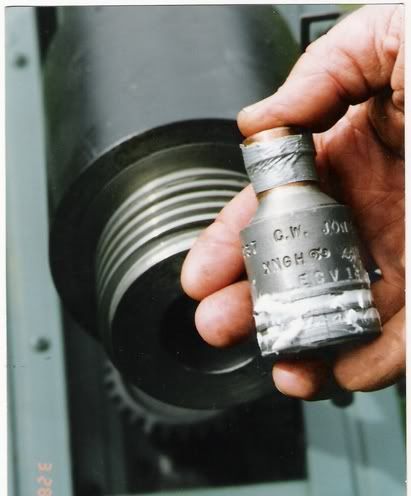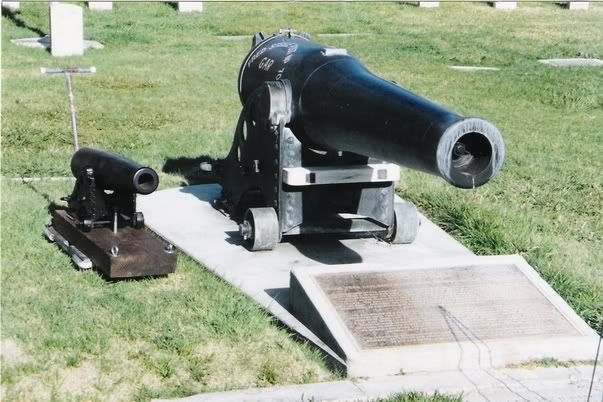The project of building “Little Bill” was a true learning experience, especially for someone who has no formal training as a welder, artisan, machinist, or cannoneer. However, to best understand scope of the entire project, a little background information is needed...
For over a decade, a group of West Coast cannoneers, craftsmen, anvil firers, and black powder enthusiasts gather annually for an invitation only weekend-long fete. Organized under the banner of GE&SOP (alternately defined as either Gathering of Esoteric & Seasoned Old Time Powder-Users or Grand Erection and Shoot-Off Party), the festivities include a competitive cannon shoot. Participants are provided a printed keepsake, which usually highlight some aspect within the realm of black powder.
My late father in law, C.W. Jones, invited me to participate in this event for many years, and we discussed building a mortar or cannon. Life being what it is, I was not able to participate due to work and family obligations. Unfortunately, C.W. died suddenly after a brief illness in the fall of 1997 [To digress a bit, C.W. often expressed that after he died, he wanted to be cremated, have his ashes loaded into a muzzle-loading shotgun, and shot out through the front door of a house of ill repute...more on this later].
Therefore, when his friends told me that they were going to hold a memorial to him at GE&SOP 8, I knew that I had to complete the project we had long talked about.
I settled upon a building a coehorn mortar, which was used by both the North and South during the American Civil War. I ordered plans from Dixie Gun Works, and set about completing the project. Nils Karlstrom and his staff at American Iron Works were able to provide me with guidance and tips. I decided to use materials available around the shop, where I found an eight-inch diameter billet of work-hardened stainless steel, formerly a section of propeller shaft from a cargo container ship. The diameter of the billet dictated the scale of the project (3/4 scale). Not knowing anything about cannon construction, I erred on the side of safety, having the bore made to soda can diameter (2.6 inches). An employee of the shop turned the barrel on a lathe, and I fabricated the handles and other hardware from scrounged materials. This included making square nuts by shaping and tapping blanks cut from bar stock. The mortar base was made from untreated fir railroad ties.

At GE&SOP 8, the memorial to C.W., somewhat in keeping with his final wishes, included placing a portion of his ashes into an engraved 40mm projectile; after a few brief words and the playing of Amazing Grace on the bagpipes, he was launched out of a replica Whitworth rifled cannon, built by Joe Girard.

The keepsake that was provided to commemorate the weekend had a photo of a naval cannon named “Big Bill.” My interest was peaked, and decided that I wanted to build a replica of the cannon, which I would dub “Little Bill.” Luckily, the back of the keepsake contained the text of a plaque commemorating Big Bill, including a brief history of the cannon, as well as the name of Edson Strobridge, the cannon’s restorer. The next task at hand was to learn as much as I could about the origins of the cannon, as well as make contact with Ed Strobridge.
The history of Big Bill is an interesting one. Often mis-identified as a Dahlgren gun, it is actually known as a “32-pdr Bureau shell gun of 4500#,” according to artillery expert Wayne E. Stark. In an email letter sent by Mr. Stark to Ed Strobridge, Admiral Dahlgren refused to have anything to do with the design of this specific gun, as he felt that the gun was far too light for Navy use.
Mr. Stark further explained that the Navy Bureau of Ordnance designed the 32-pdr of 4500#. The term “shell gun” refers to a smoothbore gun with a chamber for the powder. “32-pdr” refers to the weight of the projectile, while “4500#” is the approximate weight of the barrel. A total of 379 of these guns were made between 1864 and 1867, and a total of 91 still survive.
Big Bill, number 333 of the series, was placed on the USS Kearsarge at the Boston Navy Yard in December 1867, where it was fired 54 times up to 1870, probably all in practice. It was off loaded at Mare Island Navy Yard, California, in October 1870, and remained there in inventory. The final disposition of the gun is noted in government records as “Loaned to Fred Steele Post G.A.R. (Grand Army of the Republic) #70, San Luis Obispo, CAL Feb’y 1892.”
Ed Strobridge, first became interested in Big Bill during the early 1970's while researching the building of the Southern Pacific Railroad. According to local history, on May 10, 1894, there was a celebration in San Luis Obispo to mark the arrival of the Southern Pacific Railroad. As part of the celebration, Big Bill was hauled from the cemetery to the Southern Pacific Depot, where it was fired in a ceremonial salute. At the time of Ed’s initial research, the gun had been neglected for decades and was in a poor state of repair.
During 1993, in preparation of the centennial of the Southern Pacific’s arrival in San Luis Obispo, Ed decided to further research the cannon’s role in the railroad celebration of 1894. However, when he went to the cemetery, he discovered that the gun was no longer there. According to the local organization in charge of the cemetery, the gun was regarded as an eyesore, and was given to a San Luis Obispo local, who hauled it to his property. Through various channels, Ed was able to convince the individual that the cannon was still the possession of the United States Navy, on loan to the Grand Army of the Republic (and their successors, the Sons of Union Veterans of the Civil War). The cannon was returned, and Ed set about the restoration of the gun, as well as the restoration of the GAR cemetery plot, which was also long neglected.
Planning and Building
Once the decision had been made to pursue this project, I had to set a few guidelines for the project. First off, I decided to build a “representation” of Big Bill, as opposed to an exact scale replica of the gun. This allowed me some artistic freedom regarding various details. I also decided that the replica had to be of a manageable size and be fully functional.
When I first contacted Ed Strobridge, he provided me with a collection of photos and drawings. His sketches included measurements, as well as all of the various markings on the cannon. I determined that the scale of the cannon would be based upon the size of stock that was readily available from a local steel wholesaler.
A three foot long billet of cold rolled steel, seven inches in diameter, was purchased at a cost of $278. The billet weighed 393 pounds. Based upon the diameter and length of the billet, the overall scale of the cannon was determined, and the adjusted measurements were transferred to a sketch of the barrel.

Next, a template of the side of the carriage was made out of plywood. This shape was transferred to steel plate, and cut out with an oxy-acetylene torch. The pieces of steel plate were welded together for strength.
The detail was added to the carriage. This included decorative rivets, the two rear skids, trunnion caps and bearing surfaces, as well as the screw mechanism. After a long search, scale steel wheels were found at a hand truck supply company in San Francisco.

The carriage was completed by Spring 1999. However, not knowing how to use a lathe, I was at the mercy of a part-time machinist at American Iron Works. I soon lost interest, and the project was shelved for approximately two years. In the Spring 2001, work resumed on the barrel. The machinist started by first boring the billet; later, he would shape the outside of the tube to ensure that the bore was on center. The plans called for a bore diameter of 1.5 inches, however, the machinist assumed that I wanted to use the same reamer as I had on the coehorn mortar, and the tube was bored to the larger, 2.6 inch diameter. Based upon the larger bore diameter, the outside dimension of the barrel was also adjusted. As a result, the trunnion had to be welded on closer to the muzzle end of the barrel (forward approximately two inches) in order to balance the barrel. The barrel was placed in the carriage, and the screws on the trunion caps were cinched down. All that was left was to paint the cannon and, of course, fire it.

In Spring of 2001, Little Bill made his debut at GE&SOP X. Plenty of black powder was procured, as well as suitable lengths of fuse. Based upon the diameter of the bore, two different projectiles were made, the first being tennis balls filled with concrete, and the second being soda cans filled with concrete. Based upon the experience of other large-bore cannon shooters, an initial charge of 400 grains of black powder was loaded in the barrel, followed by the concrete filled tennis ball projectile. The first attempts resulted in misfires. A quick examination of the barrel tube revealed the problem; the barrel, made to scale plans, contained a large powder chamber in the breech. This, combined with the angle of the fuse hole (again, from the scale plans), required a much larger powder charge to ensure ignition. After trial and error, a charge of 1,200 grains of black powder was sufficient to send a projectile 200 yards downrange.
The concrete filled tennis ball proved to be too light of a projectile, which resulted in erratic flight. The concrete filled soda cans proved to be the best projectile.
In the Spring of 2002, the SUVCW, Department of California and Pacific, held its 116th annual encampment in San Luis Obispo, California. In honor of the event, Little Bill was transported to the GAR plot, where he was photographed next to the restored Big Bill.